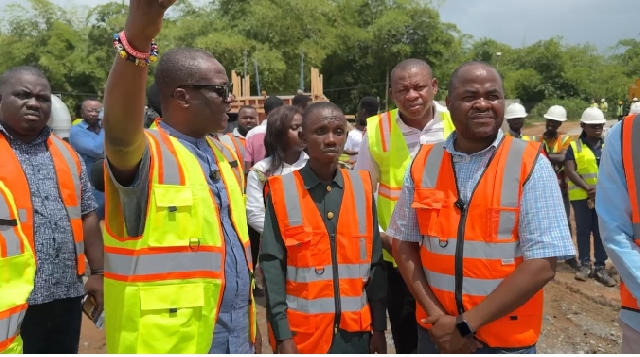Western Regional Minister orders urgent protection of Daboase water treatment plant buffer zones
 Joseph Nelson and team at Daboase water treatment plant
Joseph Nelson and team at Daboase water treatment plant
Western Regional Minister, Joseph Nelson, has directed the Ghana Water Company Limited (GWCL) to immediately demarcate and secure the buffer zones surrounding the Daboase Water Treatment Plant to prevent further encroachment.
The directive comes amid rising concerns over landowners infringing on protected areas, with many claiming ignorance of the boundaries.
The Minister, during a familiarisation tour of the facility, also instructed local chiefs to suspend all planned activities within the demarcated buffer zones to safeguard the region’s critical water infrastructure.
The Daboase plant is at the centre of a €70 million water expansion project launched in May 2022 by the Ministry of Sanitation and Water Resources and the GWCL.
The project, led by Austrian construction firm Strabag, aims to deliver 22 million gallons of potable water daily to Sekondi-Takoradi and surrounding communities.
Strabag reported that the project is 86% complete and is on track for completion by November 7, 2025.
Built in the late 1960s with a capacity of six million gallons per day, the Daboase plant—alongside the Inchaban facility, which produces four million gallons daily—has struggled to meet the growing water demands of the twin-city and its environs.
Illegal mining activities along the Pra River have further compounded the problem by increasing water turbidity, slashing the plant’s output to just above 16,000 gallons per day—a drastic drop from its original capacity.
Gideon Asare Annor, the Western Regional Production Manager for GWCL, explained that in addition to the impacts of galamsey, encroachment on buffer zones has significantly threatened the sustainability of water production, especially during the dry season.
Minister Joseph Nelson emphasised the urgency of the situation: “We cannot allow the ignorance of a few to compromise the health and well-being of thousands of residents.
The buffer zones must be protected at all costs.”
The protection of the buffer zones is expected to play a key role in preserving water quality and ensuring the long-term viability of the €70 million investment.
Source: Classfmonline.com/Simon Ahensah
Trending News

President Mahama embarks on Thank You Tour of Bono East Region today
07:04
GA/R: Tensions erupt at Tema site three as TDC demolishes shops
10:56
WN/R: Police Commander tries to free galamsey suspects arrested by forest officers in Bibiani forest district
19:07
UAE Ambassador pays courtesy call on Interior Minister to explore Ghana-UAE security collaboration
06:56
Defence Minister addresses Futures Forum 2025 at London School of Economics
12:22
Ghana Water begins controlled spillage of Weija dam
14:26
Bryan Acheampong forms committee for viability of his NPP flagbearership bid
06:42
Parliament resumes today after a two-month recess
09:41
Adentan Kumi’s wife allegedly suffers miscarriage after his arrest by NIB
15:12
V/R: Police 26 suspects over drug-related offences
19:40




